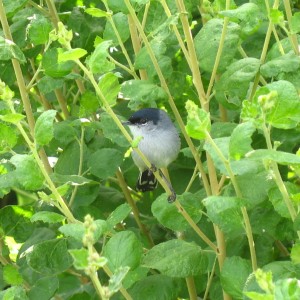 Busby Biological Services, Inc. (BBS) is currently entering the final data review and reporting stage for the “Coastal California Gnatcatcher 2014 General Inventory and Breeding Status Assessment Study on Marine Corps Base Camp Pendleton, California”. This marks the second time that BBS has participated in this large scale, Basewide study; the first was during 2010.
Busby Biological Services, Inc. (BBS) is currently entering the final data review and reporting stage for the “Coastal California Gnatcatcher 2014 General Inventory and Breeding Status Assessment Study on Marine Corps Base Camp Pendleton, California”. This marks the second time that BBS has participated in this large scale, Basewide study; the first was during 2010.
The objectives of this study were to conduct a habitat assessment to identify potentially suitable Coastal California Gnatcatcher (CAGN) breeding habitat, to conduct a presence/absence survey for CAGN, and to monitor a target of 50 CAGN nests to assess survival and productivity within the approximately 125,000-acre base. BBS served as the technical lead for this study retained by Tetra Tech Inc. The survey team was composed of U.S. Fish and Wildlife Service (USFWS)-permitted CAGN surveyors and nest monitors primarily from BBS and the San Diego Natural History Museum (SDNHM), as well as other USFWS-permited independent biologists.
The project began during the fall of 2013 with a pre-breeding habitat assessment of approximately 45,000 acres of potentially suitable CAGN breeding habitat identified from Base Geographic Information System (GIS) vegetation map layers. During the habitat assessment, the potentially suitable CAGN breeding habitat was further refined to identify approximately 20,000 acres that would require presence/absence surveys and nest monitoring for CAGN.
The CAGN surveys and nest monitoring were conducted during a 5 month period between approximately February 15 and July 15, 2014. All surveys were conducted according to the USFWS Coastal California Gnatcatcher Presence/Absence Survey Protocol for participants in the Natural Communities Conservation Plan (NCCP), requiring no more than 100 acres of suitable habitat be surveyed per day during three replicate surveys of each area. CAGN nests were monitored temporally and spatially on Base to assess survival and productivity. Nest data were analyzed using the Mayfield method for calculating nest success, which uses the period of time a nest was observed and the time of exposure to loss to calculate nest survival.
The Base has been conducting these CAGN surveys since 1989 and Basewide surveys are conducted approximately every three to four years. Results from this Basewide survey effort aid the Base in supporting natural resource conservation; compliance with federal, state, and local statutes and regulations; military readiness activities; and with Department of Defense policies, instructions, and guidance.